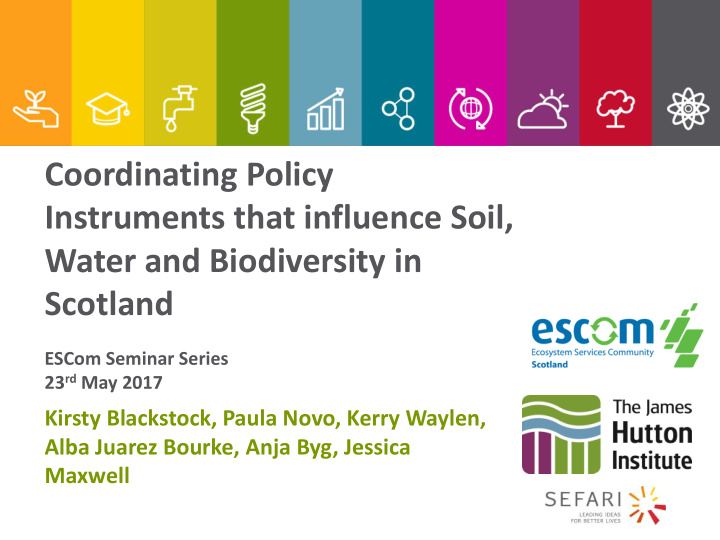



Coordinating Policy Instruments that influence Soil, Water and Biodiversity in Scotland ESCom Seminar Series 23 rd May 2017 Kirsty Blackstock, Paula Novo, Kerry Waylen, Alba Juarez Bourke, Anja Byg, Jessica Maxwell
Purpose of the Workshop To take stock of research to date 1.3.4 (Biodiversity) & 1.4.2 (Natural Assets) Check that our original rationale holds Share draft findings before more analysis Invited stakeholders with interest and expertise Chatham House Rules Frank discussions that will not be attributed to any individual Note taking and photographs
1.3.4: Why research the governance of biodiversity management? National & international policy agendas give rise to these questions: What are the different governance mechanisms that can be used to meet biodiversity and prosperity goals? How do they operate & are perceived by stakeholders? Synthesis and assessment of current biodiversity management measures Overview of different policy instruments Handling of trade-offs Factors influencing uptake and implementation Using desk based review + interviews
1.4.2: Why research integration of policy instruments? National and international policy agendas give rise to these questions: Do these policy instruments take into account each other, and the delivery of multiple benefits? Is there need for policy integration? (Policy 3 of LUS)? Could we adjust current policy instruments, to balance multiple goals? Synthesis and assessment of current Scottish policy instruments influencing soil, water and biodiversity Overview of state of the environment Long list of instruments and analysis of sub-sample (10) Degree of interaction/coordination/cross referencing Desk based review and interviews
Similarities and Differences Policy Drivers: 1.4.2 broader than 1.3.4 but many are shared Focus: instruments not parent policies or legislation Topic: 1.4.2 is about biodiversity as well as soil and water, 1.3.4 focused on biodiversity alone Geographical Focus: 1.4.2 only Scottish to date, 1.3.4 is international Definition of policy instrument : 1.4.2 only government funded; 1.3.4 all instruments Methods: difference in sampling approach but similar combination of review and interviews
Living Graph (1) Think of your personal response to the following question: To what degree are you satisfied with the way that current Scottish Biodiversity policy instruments are working? Taking the wall as the axis, arrange yourself along the wall to reflect your position on the scale – very satisfied to very unsatisfied Talk to each other to develop your relative positions If you don’t know or don’t want to answer, form an ‘island’ Be ready to briefly explain your answer
Living Graph (2) Think of your personal response to the following question: To what degree do you believe that we need more integration of biodiversity, soils and water policies? Taking the wall as the axis, arrange yourself along the wall to reflect your position on the scale – lots more integration to no more integration Talk to each other to develop your relative positions If you don’t know or don’t want to answer, form an ‘island’ Be ready to briefly explain your answer
Break Out Discussions Biodiversity Integration Paula Novo Kerry Waylen Joanna Drewitt Sandra Marks Louise Bond Helen Jones Bruce Wilson Nicola Melville Clive Mitchell Rebecca Audsley Jan Dick Sarah Govan Hannah Eamer Andy Tharme
Break out feedback How can we improve delivery? What are the challenges of doing this? Any solutions?
Discussion on Research Do these ideas resonate with your experiences? What, if anything, is missing from our analysis? Have we diagnosed the problems correctly? Does Brexit give us new opportunities?
Next Steps Evaluation Form Workshop report and blog on ESCom website 1.3.4: interviews and report 1.4.2: interviews and paper (plus briefing if requested) Lunch
Points of clarification or additional detail? Thanks to the RESAS Strategic Research Programme 2016-21 Kerry.Waylen@Hutton.ac.uk Paula.Novo@Hutton.ac.uk Kirsty.Blackstock@Hutton.ac.uk
Recommend
More recommend